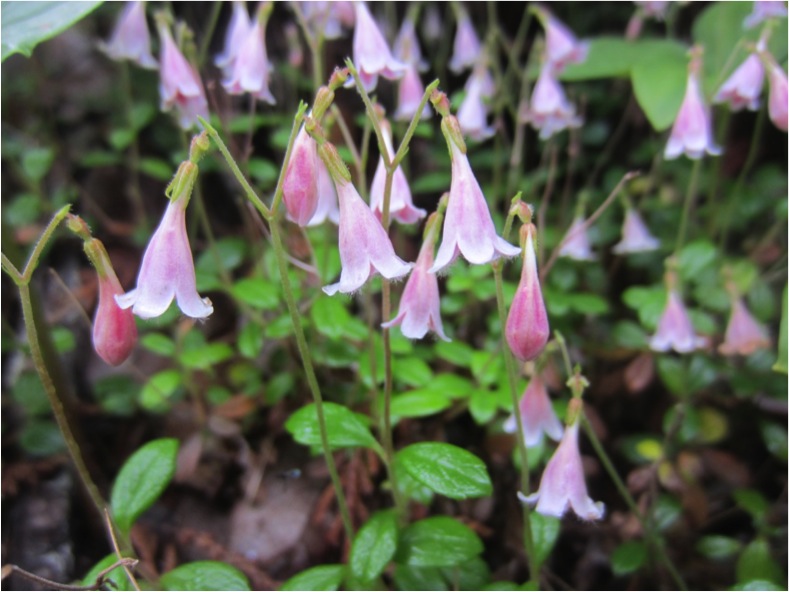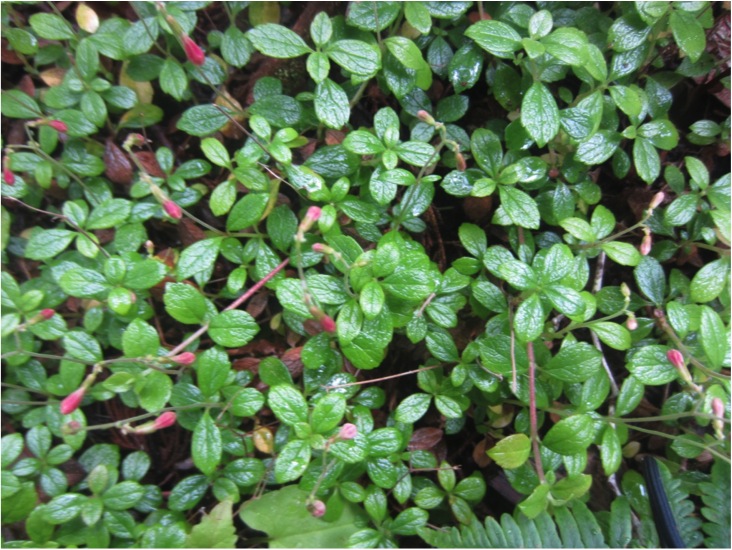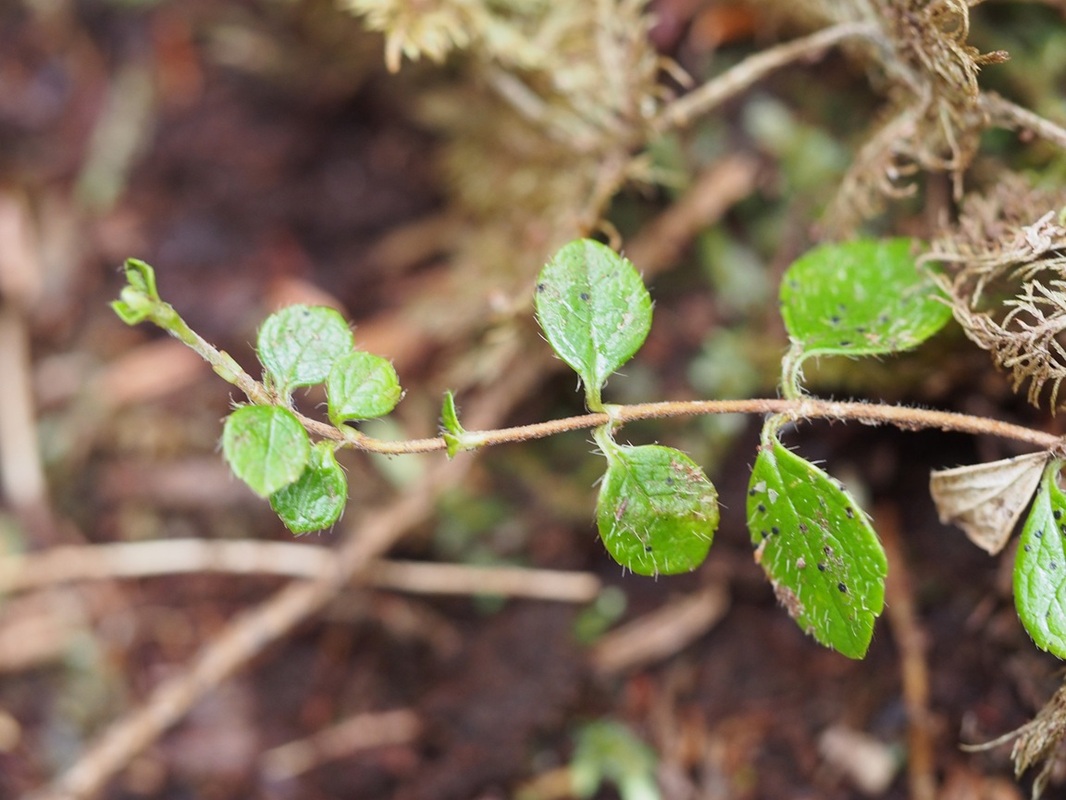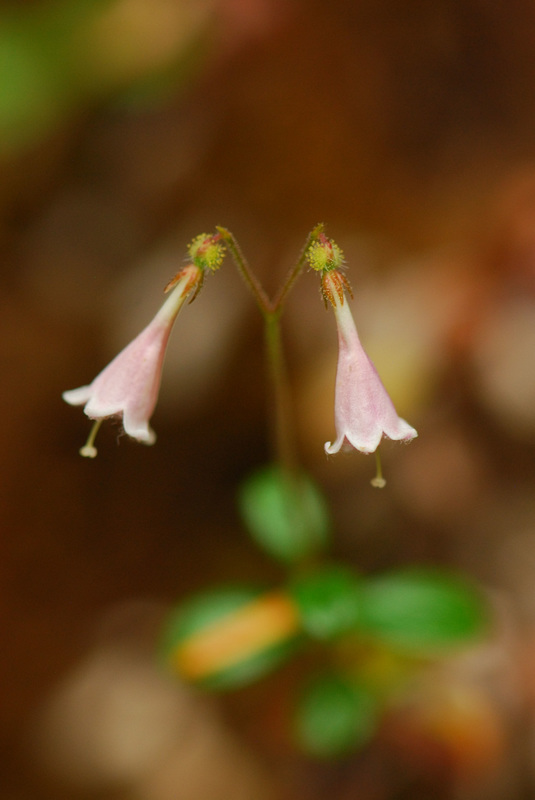Twinflower • Linnaea borealis
{Linnaea = named by the botanist Gronovius for Linnaeus, as this species was reportedly Linnaeus's favourite flower; borealis = northern}
Identification
This stems of this delicate-looking evergreen grow upright to 10 cm tall, from long runners. Short-stalked leaves branch off the stems in opposite pairs. The leaves are egg-shaped or almost circular, firm and leathery, and dark green above but pale below. The ends of the leaves may have a few small teeth. The flowers are the major identifying characteristic, however. As the name suggests, the flowers generally appears in pairs. These pairs of trumpet-shaped flowers nod or droop down from the ends of a Y-shaped stalk. They are pink to white, approximately 1-1.5 cm long, and quite fragrant. This species is actually a shrub in the honeysuckle family.
Habitat & Range
Twinflower is found at all elevations below the tree line. It grows in both shady and open areas, and prefers somewhat dry to somewhat damp habitats. Look for it in the understory of forested areas, amongst other shrubs, and along rocky shorelines. More detailed information about where to find it and associated species can be read on the E-Flora species page.
There are two subspecies of twinflower in BC. Linnaea borealis subsp. longiflora is somewhat more common in BC, and is found throughout the province. L. borealis subsp. borealis is also found in most of BC, except for the northernmost corner of the province. Together the ranges of the two subspecies cover most of North America (click here for range map). The borealis subspecies is also found in Northern Europe.
Similar Species
The two subspecies are mainly differentiated by slight flower structure differences. Linnaea borealis subsp. longiflora has 10-16 mm long, bell-shaped flowers. L. borealis subsp. borealis has 9-11 mm long funnel-shaped flowers.
Human Uses
Click here for information on twinflower cultivation.
Intriguing Info
Twinflower has been listed as 'Nationally Scarce' in the UK, and is a priority species in the UK Biodiversity Action Plan. Click here for more information.
This stems of this delicate-looking evergreen grow upright to 10 cm tall, from long runners. Short-stalked leaves branch off the stems in opposite pairs. The leaves are egg-shaped or almost circular, firm and leathery, and dark green above but pale below. The ends of the leaves may have a few small teeth. The flowers are the major identifying characteristic, however. As the name suggests, the flowers generally appears in pairs. These pairs of trumpet-shaped flowers nod or droop down from the ends of a Y-shaped stalk. They are pink to white, approximately 1-1.5 cm long, and quite fragrant. This species is actually a shrub in the honeysuckle family.
Habitat & Range
Twinflower is found at all elevations below the tree line. It grows in both shady and open areas, and prefers somewhat dry to somewhat damp habitats. Look for it in the understory of forested areas, amongst other shrubs, and along rocky shorelines. More detailed information about where to find it and associated species can be read on the E-Flora species page.
There are two subspecies of twinflower in BC. Linnaea borealis subsp. longiflora is somewhat more common in BC, and is found throughout the province. L. borealis subsp. borealis is also found in most of BC, except for the northernmost corner of the province. Together the ranges of the two subspecies cover most of North America (click here for range map). The borealis subspecies is also found in Northern Europe.
Similar Species
The two subspecies are mainly differentiated by slight flower structure differences. Linnaea borealis subsp. longiflora has 10-16 mm long, bell-shaped flowers. L. borealis subsp. borealis has 9-11 mm long funnel-shaped flowers.
Human Uses
Click here for information on twinflower cultivation.
Intriguing Info
Twinflower has been listed as 'Nationally Scarce' in the UK, and is a priority species in the UK Biodiversity Action Plan. Click here for more information.
References
Linnaea borealis L. In Klinkenberg, Brian. (Ed.). E-Flora BC: Electronic Atlas of the Plants of British Columbia. Lab for Advanced Spatial Analysis, Department of Geography, University of British Columbia, Vancouver. Accessed 14/08/2013.
Pojar, J. and MacKinnon, A. (1994). Plants of Coastal British Columbia. Vancouver, BC: Lone Pine Publishing. P. 68.
Twinflower (Linnaea borealis). ARKive.org. Accessed 14/08/2013.
Authors and editors of page
Kelly Fretwell and Brian Starzomski (2013).
Linnaea borealis L. In Klinkenberg, Brian. (Ed.). E-Flora BC: Electronic Atlas of the Plants of British Columbia. Lab for Advanced Spatial Analysis, Department of Geography, University of British Columbia, Vancouver. Accessed 14/08/2013.
Pojar, J. and MacKinnon, A. (1994). Plants of Coastal British Columbia. Vancouver, BC: Lone Pine Publishing. P. 68.
Twinflower (Linnaea borealis). ARKive.org. Accessed 14/08/2013.
Authors and editors of page
Kelly Fretwell and Brian Starzomski (2013).







